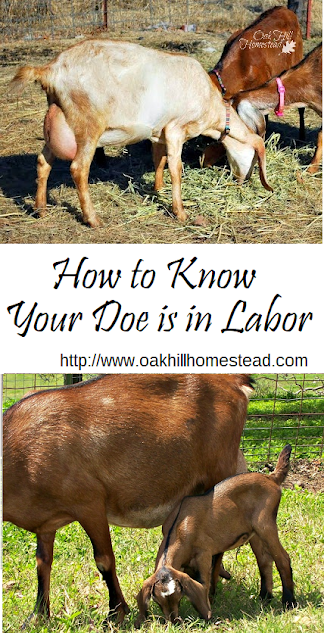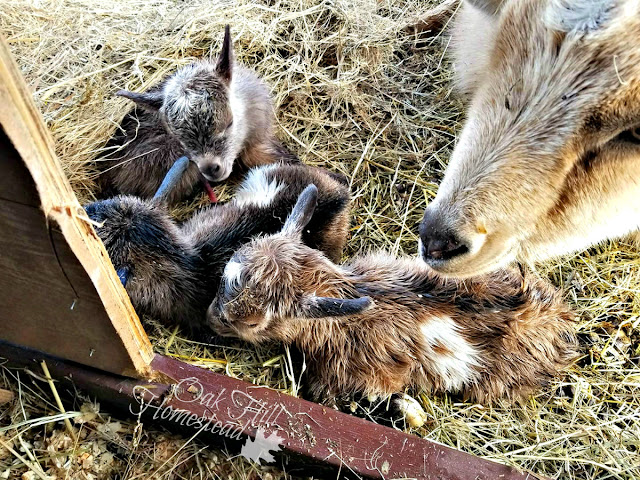How can you tell your goat is about to give birth? Here are some subtle and not-so-subtle signs that your goat is in labor. From physical signs of labor to some goat kidding behaviors, here's how you'll know your goat is ready to kid.
How to know your goat is in labor
Have you worried about how you'll know your goat is in labor? Here are some subtle signs of impending goat labor, and a video showing the birth of a goat kid.
It's important to know your doe's due date, but sometimes you just don't know. Ginger, my Nigerian Dwarf doe, was bred when I purchased her and the previous owner didn't know when she was due.
Nigerian Dwarfs are known to have large "litters" and as Ginger grew bigger and bigger, with no signs of kidding in sight, I worried about how many kids she was carrying.
The more kids there are, the more chance there is for tangled-up kids or mispresented kids (breech, for instance) when labor finally sets in.
Fortunately Ginger had no kidding complications and each kid was born front-feet-and-head first as they should be. The video in this post shows her delivering kid #3.
Subtle signs a goat is in labor
For weeks before her due date, one of my full-size Nubian goats Firefly looked as though she was going to kid at any minute.
It's just the way she is. Her udder begins to form, eventually getting so large that she rubs the hair off the sides of it as she walks. Her tail ligaments are "mushy" for several weeks.
Two weeks before she finally kidded, her kids dropped into position and her flanks were hollowed out. I knew she was close to kidding, but I began to wonder how I'd know when she was actually in labor.
Three days before Firefly's due date, I was ready to drive to town on an errand when I looked in the rearview mirror and realized I didn't see Firefly with the herd.
I went to check on her and found her standing alone in the goat shed.
My goats are usually very polite and considerate when a doe is in labor. They leave the mom-to-be alone in the shed so she can have privacy. Sometimes the doe's mother or best friend will stay with her, but the rest of the herd goes elsewhere.
Since goats are usually very social, finding Firefly alone meant I needed to watch for a few minutes.
I didn't see contractions, but every so often her tail would stretch upward for a few seconds.
In the past I've also noticed that some goats tighten the muscles in her face, grimace or "smile," grind her teeth, and/or grunt.
Some of my Nubians pin their long ears back when they have contractions.
These are pretty subtle signs of goat labor that would be easy to miss if you don't know what you're looking for, or if you're not paying attention.
I postponed my errand, parked the truck, and decided I'd sit in the pen with her for awhile and watch her.
In spite of my thinking that I'd sit for awhile and keep watch, in less than twenty minutes from when I first saw her she'd delivered twins.
As you can see, labor can progress quickly in goats. So how do you know when it's "time"? What goat kidding signs should you be looking for?
What to watch for as your goat's due date approaches
Gestation in goats is normally 150 days, give or take a few days. Figure 145-155 days for full-size goats like my Nubians, and around 140-150 for miniature goats such as my Nigerian Dwarf doe Ginger in this post's video.
As your goat's due date approaches, you might notice some physical signs of kidding such as being able to "wrap your fingers around her tailbone" with your fingers almost touching your thumb through her skin, and that her tail ligaments have softened to prepare for birthing.
Her udder might fill and be enlarged, although sometimes it won't fill until after she gives birth. Her hips might hollow out, and her rump might looked as though she's "hunched up."
Signs of early labor in goats
The signs of early labor can be quite subtle at first. Here are some signs of kidding in goats to watch for:
- Standing off by herself, away from her herd mates
- Signs of contractions such as grimacing, pulling her ears back, grunting softly, grinding her teeth, sticking her tongue out, or stretching her tail upwards at regular intervals
- Pawing at the ground
- Turning in circles, restlessness
Early labor can last for several hours, but it probably won't be noticeable at first. Even if you miss these early signs, once she's in earnest labor you'll know it!

First signs of active labor in goats
The second stage of labor - active labor - is when the doe begins actively and noticeably pushing her kid out. From the time she begins pushing until the kid is born should only take about thirty minutes.
If labor hasn't progressed by then - if a kid hasn't arrived after thirty minutes of active pushing - you'll need to investigate to be sure the kid is presented correctly, with two front hooves and a nose coming first.
If the kid isn't presented correctly, if multiple kids are tangled up inside, or if it's a large kid that's just plain stuck, you or a vet might need to intervene, as I had to in this difficult kidding when Dream, another of Nubian goats, kidded.
It's important to know your doe so that you will notice behavior that's out of the ordinary.
First fresheners are challenging because you don't have a kidding history, but standing off by herself when normally she'd be in the middle of your herd is a good indication that you need to take a second look, whether she's pregnant or not.
Knowing what to look for - the subtle signs that kidding is near - will help you to be prepared and be confident when labor occurs.
How to assemble your own goat kidding kit - and more
My Goat Keeper’s Essentials Collection includes a guide + checklist to help you assemble your own goat kidding kit/birthing kit, keeping you prepared for any surprises when kidding season arrives!
The collection also includes detailed goat supplies and first-aid guides and checklists - plus BONUS directions to make your own no-sew kid coats - all in one printable download for your goat binder or homestead notebook.

As a goat lover and a homestead gardener, I'm excited to also share my gardening tips with you - from planting seeds to enjoying the fruits (and vegetables) of your labor! You can find my gardening advice and insights right here, so let's dig in and cultivate some fresh, delicious produce together.

Related posts:
A Difficult Kidding
What to Put in Your Kidding Kit
~~~~~
My hope is to inspire you, and to encourage your homesteading plans and your dreams of a
Instagram | Facebook | Pinterest | Subscribe














